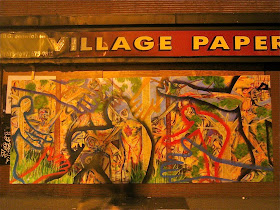Recently, rumors have come out about the closure of the Chinatown Fair Arcade on Mott Street.
Bowery Boogie shares a video of the manager who says he can't make money here and "runs the arcade for the community." Boogie reports: "store manager Henry Cen lost his lease on the Mott Street space, and will be
moving out March 23."
 New York Daily Photo
New York Daily PhotoIt's not the first time closure has been threatened here. In 2007, a
For Rent sign showed up on the arcade, but the Fair survived. In 2008, a reader named Ben told us the For Rent sign was back: "Now you can't even see the old ghost lettering for the Tic-Tac-Toe chicken. Worst of all, it might close!" But it didn't.
This past weekend, an employee of the arcade
responded to the current rumors, saying, "
the truth is, that cf maybe relocating to williamsburg, brooklyn if disputes with the landlord r not settled. CF IS NOT CLOSING."
 photo: Ben
photo: BenThe Chinatown Fair has been around since at least the 1950s, and possibly as early as 1944, when it was run by
Frank Gee, who helped establish the Chinese American Legion post, holding tea parties for the organization in his arcade after World War II.
Author Bruce Hall recalls in his Chinatown memoir
Tea That Burns when the arcade was owned by Frank Gee and was "noted for its pinball machines,
shooting gallery with real bullets, and funny little 'museum' with its golden globe encircled with snarling dragons."
 1958
1958But the Chinatown Fair's greatest claim to fame was its
Tic-Tac-Toe Chickens. They were written about, more than once, by Calvin Trillin. In a 1999
New Yorker piece, he dug deep into the story of the birthplace of the tic-tac-toe chickens:
They were trained in Hot Springs, Arkansas, by former students of famed behaviorist B.F. Skinner.The same people, Trillin informs us, had created "such acts as a Vietnamese pig that drives a Cadillac and a parrot that rollerskates, a chicken that dances while a rabbit plays the piano and a duck plays guitar." Similar chickens trained here have also "told fortunes and sold postcards and played baseball."
According to the Arkansas folks, the first tic-tac-toe chicken was installed on Mott Street around 1974. Their chickens were unbeatable. They even beat B.F. Skinner.
 from the New Yorker
from the New YorkerOne long-time Chinatown Fair chicken, named Willy, died in 1993 and received a moving
obituary in the New York Times, which stated: "The bird was still smart enough to take our 50 cents. It was not like meat from Frank Perdue. It was our playmate, and since we have always been a particularly self-centered species, that elevated it."
 1994, Michael Yamashita/Corbis
1994, Michael Yamashita/CorbisOne of Willy's successors, called Lily, was
rescued in 1998 by a concerned chicken lover and set free in Massachusetts to frolic with other farm animals. She may well have been the last tic-tac-toe chicken at the arcade.
(If you run a casino and would like to sponsor your own Tic-Tac-Toe Chicken Challenge, write to
a guy named Bunky in Arkansas. He still trains his chickens using the Skinner method. If you just want to play a chicken, head to Foxwoods, where if you beat the chicken you win $10,000--
check out the movie.)
 photo: Elaine Norman
photo: Elaine NormanSometime in the 2000s,
the word CHICKENS disappeared from the arcade's sign.
Chickens was plural because, in addition to the tic-tac-toe chicken, there was also a dancing chicken, whose life was maybe not as intellectually stimulating as the tic-tac-toe chicken's.
 Adam Woolfitt/Corbis
Adam Woolfitt/CorbisWhat has remained at the Chinatown Fair, without the chickens, are lots of arcade games and lots of dedicated gamers.
Scouting NY recently went inside to take pictures, and last year
The Times did a profile on the place.
They wrote: "
Chinatown Fair has become a center for all the outcasts in the city to bond over their shared love for a good 20-punch combo and 'old school' games that more popular arcades don’t stock anymore." But its glory has been fading for awhile. Said one gamer to the
Times, the arcade is the "Last of a dying breed."
Its move to Brooklyn will be another blow for any such outcasts left in Manhattan.

























































